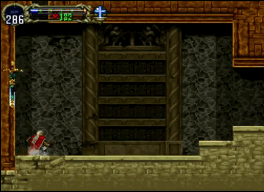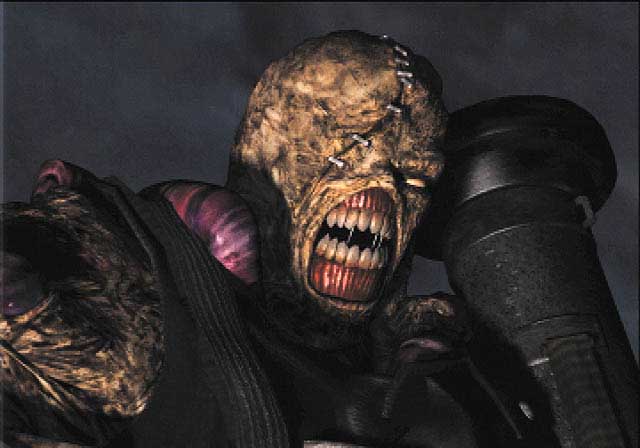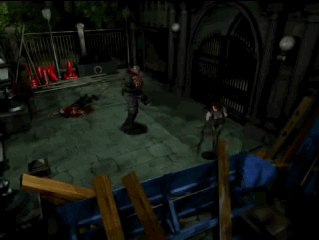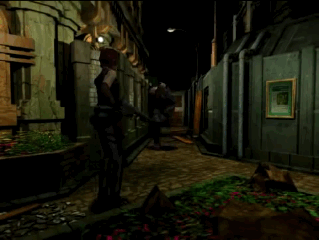The Complexities of Castlevania: SOTN – Traversal
December 1st, 2017
[When developing Castlevania: Symphony of the Night, director Koji Igarashi wanted to make a game which would “overturn player’s ideas about Castlevania, yet also feel like a Castlevania game”. In pursuing this vision, his team made SOTN’s game system much more complex, incorporating RPG systems and a wide variety of nuanced player actions. This series of articles will examine how these additions shape SOTN’s core gameplay of moving through space to dodge and attack enemies.]
When Igarashi’s team were drafting up Alucard’s (the player avatar) ability set, they drew upon the framework established over the course of earlier Castlevania titles. However, the developers also made some alterations and introduced new mechanics which give SOTN its own particular character. I’ve picked out a few details (both new inclusions and series staples) which speak to the way SOTN mechanics and mechanical properties shape the nature of traversal and movement.
- Alucard walks at a constant speed and doesn’t gain momentum, which is appropriate given his relative size within the environment. As such, the player has enough time to see and react to the obstructions as they come into view.
- The player can control the height of Alucard’s jump through the length of button press and so the input has a direct relationship to the on-screen output which allows for a more intuitive sense of control.
- Alucard falls reasonably quickly, and so like the NES Castlevania games the player has little leeway to adjust their jumps in mid-air. In this way, SOTN prompts players to mentally foresee their complete jump trajectory before moving off the ground. For a lack of better word, the players need to play with more intentionality. This is particularly true in boss encounters where bad jumps can punish the player.
- Player’s can upgrade to a double jump with the leap stone relic. The second jump height is shorter than the first. The reason being that fitting two differently shaped pieces together when planning your jumps is a much more interesting spatial challenge than combining two equal halves.
- The extra hop gives the player two levels of added control over the jump. They can choose when to do the second jump and how high to make it. These options facilitate various types of higher level manoeuvres such as floating, high jumping, and hopping. A good amount of gameplay potential can be extracted out of a reasonably simple addition.
- With two jumps, players can also react to any sudden changes in the environment when Alucard’s mid-flight. In this sense, only having the single jump available at the start of the game encourages the player to be more cautious and observe more of their surroundings. Some time later, once the player is more in tune with the dangers of Dracula’s castle, the game provides them the means of better navigating around these dangers.
- Alucard can high jump when the gravity boots relic is equipped. The inputs (press down and up on the d-pad and then jump) make the mechanic distinct from jump and double jump. However, the somewhat particular rules governing the mechanic’s execution (Alucard can perform a high jump when on the ground and after a double jump, but not after a regular jump), cloud the technique with some ambiguity. Also, the screen-high ceilings of Dracula’s castle limit the applications for a jump which stretches two and a half screens tall. The occasional hall or exterior setting provide opportunities for players to use the technique, but pepperings of enemies in these areas restrict these few potential spaces. Furthermore, the bat form allows Alucard to navigate vertical spaces with much more foresight than the high jump. So although the high jump looks flashy, it doesn’t offer much functionality.
- When in the air, Alucard can do an air kick, slicing straight down or diagonally. As with high jump, the particular nature of the mechanic limits its functionality. The player must double jump to perform the technique, which increases the complexity of envisioning the attack and its trajectory in the mind’s eye. In terms of traversal, the diagonal kicks make light work of staircases. Players can also exploit the technique’s rebound (which allows Alucard to enter into another kick) to skim across a series of light fightings or off the heads of a row of enemies. Although highly satisfying, such techniques are too nuanced and the applicable situations too few for the majority of players to incorporate into their repertoire.
- The back dash is a quick backwards retreat that acts as a dodge move. It’s also a viable, if not unorthodox alternative to walking (and by the looks of most SOTN speed runs, a faster method too). Alucard’s animation state suspends between rooms, making it possible to continuously moon walk your way through the castle.
Overall, we can see that the complexity added to Alucard’s repertoire of traversal mechanics both in terms of the number of mechanics and the complexity of each mechanic lead to more nuanced-driven gameplay. I would argue that very little of the nuance (probably only the extra hop in the double jump) has the ease of use and functional benefit to serve your average play in any meaningful way. (On the contrary, these nuances help buoy the SOTN speedrunning scene). The inclusion of these nuances as well as mechanics with particularly narrow functional purpose clutter SOTNs play experience with unviable options.
Resident Evil 3: Killing Nemesis (Level Design and Movement)
November 3rd, 2017
Having extensively researched Resident Evil: Code Veronica‘s level design last year, I set myself an extra challenge when recently completing Resident Evil 3. I decided to defeat Nemesis (the Terminator-esque monster who ruthlessly pursues the player) in all 11 encounters with him throughout the game. Although my playthrough was greatly lengthened by the pursuit, the experience helped me better understand classic Resident Evil movement and combat and why they’re perhaps not so fondly remembered.
Level Design
Resident Evil 3‘s interlinked city environments belong to the Resident Evil 2 style of level design. The player traverses each main area about two or three times before moving onto the next. Usually one of the backtracking paths will feature new enemies or situations to surprise players. By contrast, Resident Evil 1 takes place entirely within the a single interconnected environment and can therefore craft more folded and organic level design. Code Veronica draws from both styles and as such I think it probably would have been a better title to close the trilogy, at least in terms of level design variety.
Jill’s path through Racoon City runs through a series of laneways and buildings which wind around numerous roadblocks resulting from the city’s decay. Yet while authentic to the game’s overall theme of aftermath and destruction, the mishmash of loosely associated environments don’t lend themselves well to memorisation. In particular, the linked rings layout of Downtown don’t break down into manageable shapes.
Movement
The player can make Jill run by tilting the analogue stick forward. By then tilting the stick to one of the adjacent diagonal positions, Jill will turn whilst running. However, if the player tilts too far in one direction and the input registers as a tilt to the left or right, Jill will stop running and rotate on the spot. The analogue nature of the dual shock stick makes it difficult to identify the sweet spot between the diagonal and horizontal input selections. So I found that I would sometimes inadvertently stop Jill dead in her tracks, thus leaving her vulnerable to attacks. This problem usually occurred in the Nemesis battles, which require Jill to tightly circle the monster.
Resident Evil 3 features a quick dodge mechanic where the player can avoid attacks by aiming and firing their weapon as an enemy attacks. The unintuitive button configuration speaks for itself in that sometimes the player will attempt to attack, but will instead dodge, and vice versa. In this way, the game’s output betrays your own input. The timing needed to execute the quick dodge is also extremely tight (on hard mode). And even though I defeated Nemesis on every occasion, I could never intentionally perform a dodge. Sometimes the dodge animation will put Jill in a position where she will take damage or cannot avoid the subsequent attack. For all of the reasons, I found the mechanic to be rather unreliable.
The quick turn (another new mechanic) also has its own quirks. In order to have Jill turn 180 degrees and run in the opposite direction (which is usually what you want her to do after turning), the player must press square and tilt down on the analogue stick before then tilting up to initiate the run. For quickly fleeing from enemies, the input process is simply too complicated.
The transitions when moving between prerendered backdrops require the player constantly recalibrate their orientation, which in the midst of a fight can understandably lead to error.
Beating Nemesis
Doing a “kill Nemesis” run fundamentally changes the nature of the game. Nemesis takes a load of firepower to down, so players must set aside a major portion of their munitions for the task. Given your regular neighbourhood zombie also seeks to drain you of resources, saving ammo translates to avoiding zombies, which requires a good understanding of their placement, direction, avoidance strategies, and reset options (leaving and re-entering a room). So by focusing on Nemesis, you stress a different area of the game system.
In terms of confronting the monster itself, the trick is to run around him, turn, shoot, and repeat. You must always brush past his shorter left-arm, as his right-arm has much greater reach. You must also stay within a set distance away from him, otherwise you’ll prompt him to burst out into a sprint attack, which is much harder to avoid. If you can master this simple technique, then Nemesis isn’t all that difficult…
…at least not in open environments. The first confrontation out the front of the police station provides a good amount of room to develop your technique. However, several of the subsequent scenarios take place in corridors, where you have much less wiggle room to navigate and effectively have to run into Nemesis to avoid him. Overall, I found that these confrontations tend to highlight the weaknesses in the movement mechanics, as mentioned earlier.
Metroid Prime: Federation Force Podcast Project (8+ hours of content!)
June 24th, 2017
Last year two friends and I played through Metroid Prime: Federation Force together. Overall, we invested about 80 hours into the game each, completing both the main campaign and Blast Ball on both difficulties and with all medals and unlocks. Needless to say, we enjoyed the game very much and being the savvy folk we are, we wanted to dig deeper. So over the past few months the three of us have been trading notes and partaking in a series of podcast discussions to better understand Federation Force‘s cooperative take on the Metroid Prime template. As you may have noticed from my screen name, I’m particularly fond of the Prime games. The original Metroid Prime changed my perception of the video game medium and remains a personal favourite. So I’m pleased to finally share this project with you.
Each podcast runs for about an hour in length, with hosting duties taken by yours truly. We generally start out by introducing the particular design element we wish to discuss, teasing our its nuances, and then working our way towards the higher order questions. The topics tend to follow in a sequence, so it’s probably best to start with the first podcast. However, the final podcast (a standalone recording on Blast Ball) includes our conclusion on Federation Force and isn’t a bad taster either. Unfortunately, our recording process for the first two podcasts meant that some of the audio wasn’t as clear as we would have liked. By the third episode though, everything is cleared up.
We discuss the player’s abilities and how they’re tuned to create clean gameplay and accentuate the spatial and timing dynamics. Understanding the role of space and time in Federation Force is essential for understanding the core moving/shooting gameplay.
Federation Force was rightly praised for its mission variety. We identify the different types of missions and discuss how the mission types are arranged to create variation across the campaign.
For the next three podcasts, we analyse our favourite missions starting with my pick, Incursion. This podcast focuses on the spatial arrangement of each room in conjunction with the nuances of the particular enemy sets.
Greg discusses Federation Force‘s “mine cart” level, Blender. We break down this unique level and how roles are created through the natural limitations of perspective and space.
Adrian’s favourite level, Insurrection, divides the crew into mech and mech-less players. We discuss how Next Level Games were apply to explore this gameplay concept through the differentiated catacombs of Bion.
Federation Force‘s bosses are both generous in their number and variety. We break down each boss and analyse the gameplay challenges and play strategies we employed to secure victory.
MODS and Loadouts modify the core moving and shooting gameplay by changing the player’s viable options. We discuss the implications and share our favourite combinations and strategies.
In our final podcast we dissect the sports side-game, Blast Ball and conclude by discussing Federation Force‘s place in the Metroid Prime series (sans Pinball).
I feel like we were able to have so many deep and constructive discussions because we really listened to each other, kept the conversation grounded, and chewed through our ideas collaboratively. If you’ve enjoyed this podcast, I’ve include links to the other podcasts which I’ve recorded with Adrian and Greg as part of the VG Commune on the About page.
On a final note, I can’t help but feel that our completion of this project was quite timely. At E3 Nintendo announced the development of Metroid Prime 4. However, they didn’t reveal the studio developing the game. Personally, I suspect that Next Level Games (the developers of FF) are at the helm of Metroid Prime 4 (most likely partnering with Nintendo Japan and possibly with some oversight from Retro). My reasons for are as follows:
- Kensuke Tanabe is overseeing the project and was also the producer of Federation Force, among other Western-developed Nintendo titles.
- Retro aren’t developing the title (given the rumours of bad blood between Tanabe and Retro)
- Next Level have experience working on a Prime game (and most certainly the design chops to tackle a “mainline” Metroid game) .
So, in saying all this, I think the podcasts provide a useful lens for considering how Next Level may develop Metroid Prime 4, if they are indeed working on this project. A tasty proposition in my books.










 Game Design Companion: A Critical Analysis of Wario Land 4 - $7.99
Game Design Companion: A Critical Analysis of Wario Land 4 - $7.99 Level Design: Processes and Experiences
Level Design: Processes and Experiences Speed Boost: The Hidden Secrets Behind Arcade Racing Design - $5.99
Speed Boost: The Hidden Secrets Behind Arcade Racing Design - $5.99 Adventures in Games Analysis: Volume I - $5.99
Adventures in Games Analysis: Volume I - $5.99







